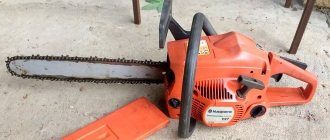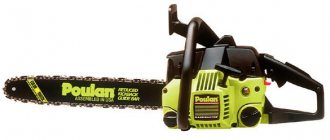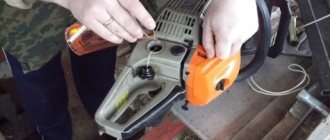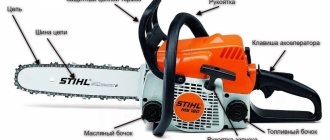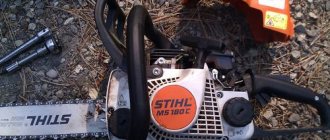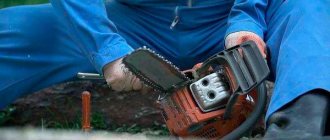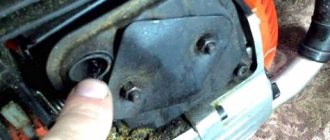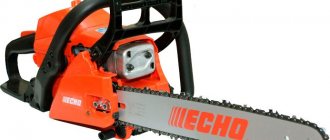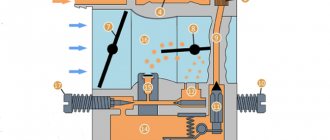Brief overview of harmful factors
It is impossible to immediately determine the reason why the saw does not start. To do this, you will need to check the tool, which is called troubleshooting. The purpose of this operation is to check the saw engine step by step and eliminate possible malfunctions.
Troubleshooting includes the following verification procedures:
- Presence of sparks on the spark plug.
- Correct supply of fuel resource.
- Filter states.
- Breather performance. which is located in the fuel cap of the tool.
- Action of exhaust valves.
Malfunctions and their elimination
The Partner three hundred 50 chainsaw malfunctions mainly due to violation of operating rules. Eliminating most problems requires experience working with gasoline tools and knowledge of the operating mechanisms of two-stroke engines.
But, as practice shows, repairing a chainsaw with your own hands is possible even in the field. Main. Correctly determine the cause of the breakdown before repair, so as not to do unnecessary work and not aggravate the situation.
Therefore, it is important to make adjustments and maintenance work on time, so that later you do not have to repair yourself in unsuitable conditions.
Sparks on the spark plug
Checking the spark on the spark plugs is the first step in diagnosing the unit.
The most common reason why a saw refuses to work is a malfunction of the spark plug electrodes.
The reasons why the ignition device stops working may be as follows:
- Incorrect carburetor adjustment.
- Increased oil level in gasoline (acceptable oil content depends on the specific chainsaw model).
- Contamination of the air filtration system that interferes with their operation.
- Excess fuel in spark plug channels.
- Disconnection of the high-voltage cradle to the end of the spark plug.
- Ignition unit failure.
Expert opinion
Kulikov Vladimir Sergeevich
All of these factors lead to the growth of charred accumulations on electrical conductors. Deposits prevent spark formation. Therefore, instruments cannot function when cold. Lack of maintenance of the filtration system and the engine power supply system leads to the gradual spread of corrosion. Excessive narrowing or widening of the gap will cause the saw to malfunction.
Spark test
To check the spark, follow a few simple steps:
- The tip of the high-voltage wire is removed.
- The candle is unscrewed.
- The tip is put on in its original place.
- The candle leans against the cylinder by means of a skirt.
- The starter starts the unit.
Spark plugs from different manufacturers require different distances between the electrodes. For certain models, a distance of 0.5 millimeters is the norm. For other chainsaws this figure is 0.02. Before conducting an inspection, it is important to understand the specifications of a particular tool.
Video instructions for finding a spark on a chainsaw
Excess of gasoline
Filling the spark plug channel with gasoline is another common cause of chainsaw malfunction. The owner of the tool can cope with this problem on his own.
To prevent damage, the following manipulations are performed:
- The spark plug is unscrewed using a specialized wrench.
- The candle is wiped with a sterile and dry cloth.
- The part is thoroughly dried for half an hour.
- Carbon deposits are removed from the electrodes using a needle file.
- The distance between electrical conductors is adjusted.
- The remaining fuel fluid is drained from the spark plug channels.
- The saw is reassembled and started again.
If the problem was an excess of fuel, then the listed procedure will return the cutting tool to “life”.
It happens that the saw stalls due to improper operation of the ignition unit. This part cannot be repaired, regardless of whether it is performed by an amateur or a specialist. The only method to combat this factor is to replace the block.
Separately about the breakdown of the most common model
Let's look at the problems of Shtil 180 in more detail:
- Clogged carburetor or fuel filter. These are the most common problems that can be easily resolved after cleaning. Sometimes the filter has to be changed;
- Replacing the spark plug;
- Sometimes the cylinder or seals need to be replaced.
The Shtil saw is quite strong and durable, so you can often fix a breakdown yourself. In fact, the same applies to the Partner, Ural, Makita and Husqvarna models.
When we discover a malfunction in our chainsaw, we look for the cause in small ways, gradually checking and eliminating the problems. Such problems are easy to fix yourself. But if the breakdown is serious, and you do not have enough experience, then this should be done by a specialist.
Fuel resource supply
Sometimes the saw owner forgets that he forgot to replenish fuel supplies.
The problem of fuel shortage is solved very simply - a new portion of the mixture is poured into the tool. If there is a sufficient amount of fuel in the tank, then an obstacle occurs at the stage of fuel entering the carburetor.
Checking the fuel line is carried out as follows:
- The fuel system pipe is disconnected from the engine system assembly.
- Paging is done manually.
- The fuel supply is monitored.
Insufficient gasoline pressure is explained by one of three conditions:
- Clogged channel responsible for fuel supply.
- Clogged fuel filters (occurs as a result of the accumulation of debris).
- Overfilled tank (if there is too much fuel, the gas line may be blocked).
Fuel supply in systematic jerks indicates the serviceability of the gas pipeline.
Expert opinion
Kulikov Vladimir Sergeevich
A symptom that indicates an overfilled tank is the presence of smudges. They are located in the space under the chainsaw crankcase cover. The detection of this symptom indicates the need to check the fuel supply pipe. Excess fuel leads to extrusion of individual sections of the wire, which impedes its passage. The lid of the barrel, which is filled to the top, does not allow the engine to start working.
Fuel quality
In addition to incorrectly pouring gasoline, the quality of the product also matters.
It falls in situations where the owner of the saw does not follow the rules for using the tool. The standard scenario includes several stages:
- A chainsaw is used to process the material, after which a small amount of gasoline remains in it.
- The owner of the tool does not pay attention to the remaining fuel and leaves the tool for several weeks.
- The formation of resin in the tank is activated.
- Over time, cylindrical cartridges become covered with a layer of charred growths.
The build-up, in turn, prevents the spark from flowing. As a result, the owner of the tool has to re-disassemble and clean the parts. This procedure can be avoided if you fill in the required amount of gasoline in advance.
If a portion of fuel still remains, you need to get rid of it. Fuel can remain in the tank without consequences for no more than 10 days.
Starter device
The design and principle of operation of a chainsaw starter
As the power of the chainsaw increases, the amount of fuel mixture increases, which must ignite when the chainsaw is started. In this case, to start the engine, it is necessary to increase the number of pulls on the starter cord. To speed up the return of the drum mechanism, manufacturers use a special steel starter return spring, which has excellent elasticity.
Chainsaw starter spring
If the spring breaks, you must: remove the mechanism cage, pull out the spring, fixing its upper part with your finger and slightly pulling the starter handle to the side
Then, wind the new part, while avoiding kinks and twisting of the new spring element, then carefully fix the clip
How filters work
The next most popular cause of saw malfunction is clogged filters. The cutting tool consists of two filters - air and fuel. These parts are responsible for different processes, but equally contribute to cleansing and trap foreign particles.
Fuel filter
Checking the operation of the fuel filter is carried out as follows:
- The fuel supply channel is disconnected from the carburetor.
- Gasoline is being pumped.
- The supply of fuel is monitored.
- If gasoline flows under low pressure (or does not flow at all), then the conclusion is made that the fuel filter is clogged.
- All gasoline is removed from the tank.
- The filter element is detached using a hook.
- The replacement cartridge is being cleaned. If desired, you can skip this step and replace the clogged filter with a new one.
- The saw is going back.
Filters tend to become dirty over time. Therefore, experienced chainsaw owners clean filters as a preventative measure. The frequency of this procedure depends on the conditions in which the master works. If there is a lot of dust in the workshop, the cartridges become dirty faster.
Air filter
As a result of a clogged air filter, the saw engine begins to operate unstably. In practice, this factor leads to periodic switching off of the saw or difficulties with starting. The absorbent material accumulates dust and dirt, a large volume of which leads to complete obstruction of the membrane. When air stops flowing into the system, the gasoline becomes too rich.
The air filter is cleaned according to a similar scheme:
- The chainsaw is opened and the air filter is removed.
- Removing the filter prevents dust particles from entering the carburetor.
- The cartridge is disconnected and cleaned of accumulated dirt.
- The surface of the filter is treated with washing liquid.
- The element is thoroughly dried.
- The saw is going back.
Breather
Disadvantages of the saw
On the Russian market you can find low-quality fakes of the Partner 350 chainsaw, which is not only additional evidence of its popularity, but also harms the brand as a whole. And other models of this brand are popular with summer residents and farmers.
If you are ready to consider the Partner 350 as your home tool for sawing thin trees, trimming branches and other not very voluminous work, then you should also know the disadvantages, most often mentioned by their owners:
1. The vibration damping system is not of very high quality, as a result of which the hands get tired quite quickly. But, considering that this is a household tool that requires 15–20 minutes of rest every 20–25 minutes of work, you can put up with this drawback.
2. Oil leakage from the chain lubrication system, which, however, affects most chainsaws equipped with it, including the more famous relative of Partner chainsaws - Husqvarna. (link)
3. Lack of visual control of the oil level, which is not very convenient in operation, and operating the saw without lubrication will lead to rapid stretching, overheating and wear of the chain.
Of course, you can use this saw to cut down a tree up to 30 - 35 centimeters thick, but its main purpose is to work on the site. Therefore, in conclusion, we offer you the most objective video review of this model:
We recommend other articles on the topic
Electric reciprocating saw - features of selection and use
Forstner drill bit for wood - features of choice, drill sharpening
Electric impact wrench - what are the advantages of the tool?
How to make a stand for an angle grinder with your own hands: drawings, design
Breather check
The breather is a part that some chainsaw owners don’t even realize exists. However, it has a significant impact on the operation of the instrument and keeps it in good condition. The breather is located on the fuel tank cap - at the location of the hole for air circulation.
This element performs the functions of a valve and is responsible for two tasks:
- Prevents gasoline from leaking out during saw operation.
- Adjusting the pressure of air flows, which is required for the smooth flow of fuel into the carburetor.
Expert opinion
Kulikov Vladimir Sergeevich
A dirty breather causes the chainsaw to constantly stall when cutting. At the moment of starting, the tool may simply not start. These consequences are due to the lack of air - due to the blockage of the hole through which it passes. As a result, the tank turns into a vacuum, which blocks gasoline from reaching the carburetor.
To recognize this problem, you need to do the following:
- The fuel supply hose is disconnected from the carburetor.
- The condition of the gasoline is analyzed: if the fuel continues to flow in an even stream, then the breather is in good condition. Uneven movement of fuel indicates that the breather is clogged with dirt particles.
- The breather is cleaned using a needle or a jet of compressed air.
Adjusting the carburetor of the Partner 350 chainsaw
This is the most frequently performed procedure when servicing a chainsaw, performed by the owner himself, so it is worth learning. It is similar to adjusting the carburetors of most chainsaws and is described in sufficient detail in the proposed video:
It is important to complete it by adjusting the idle speed screw, which ensures that the chain remains stationary when operating in this mode. If the chain does not stop at the lowest stable speed, this indicates that the clutch needs repair and the saw is unsafe to use.
Diagnostics of exhaust channels
Clogged exhaust channels or their mufflers are another non-obvious reason for a chainsaw not working. In addition to problems with starting, clogged channels manifest themselves in a decrease in the power of the tool. Exhaust channels are susceptible to accumulation of tar deposits. They focus on spark arrestors or muffler ducts. The reason for the formation of these deposits is the use of low-quality gasoline or oil. These components prevent the tool from venting exhaust gases.
Repairing the exhaust channels is easy for the owner of the saw to handle on his own. The only difficulty is the depth of this part. To get to it, you need to have a good understanding of the structure of the saw.
The instructions consist of several steps:
- The muffler is removed (to do this you will need to unscrew the screws).
- The cooling plate and mechanical seal are removed.
- The spark arrestor is removed.
- The resonator body is disassembled.
- The elements are washed from carbon deposits using a cleaning solution.
- The elements are thoroughly dried.
- The saw is going back.
During disassembly, it is easy to be careless and allow sand to get into the cylinder. To prevent this from happening, it is important to first cover the engine exhaust port with a sterile cloth.
Disassembly diagram
Repair of gas-powered tools always begins with disassembly. Follow the following pattern:
- Remove the clutch cover;
- Remove the handle and unscrew the screws, remove the starter cover;
- Remove the gasoline supply hose from the fitting cover;
- Remove the cover of the walk-behind tractor and unscrew the screws. Remove the body;
- Disassemble the clutch drum (otherwise the ignition module cannot be removed) by turning the crankshaft clockwise until the gas outlet is closed by the piston;
- Remove the clutch, unscrew the clutch (you will need a hammer);
- Unscrew the screws and remove the tank.
Please note: Russian and imported models have the same design. Therefore, there will be no problems with disassembly
Prevention
Improper care and use of the tool will shorten its service life. To extend its service life until the next repair, it is necessary to follow some preventive recommendations.
- Before each start, check the serviceability and tension of the chain, as well as the sharpness of the teeth.
- During the sawing process, give the tool a periodic rest, especially if we are talking about household or semi-professional class chainsaws.
- After completing the work, clean the chain, tire, air filter, housing and other cracks and grooves where sawdust could get in.
- Rotate the tire periodically to ensure even tire wear.
- Use only high-quality types of oils and fuels.
- You cannot store the fuel mixture for a long time, so drain the remainder from the tool and dispose of it.
Work should only be carried out when you are sure that everything is in order. Performing such simple preventive procedures can significantly extend the service life of the tool.
Other reasons
How do you diagnose a saw?
On your own From a master
The reasons why a chainsaw turns off are not always obvious. If all the above methods do not help, there are other possible problems.
The following elements are subject to diagnostics:
- Compression in the cylinder.
- Compression in the crankcase.
- Carburetor operation.
Expert opinion
Kulikov Vladimir Sergeevich
Users who are not well versed in the structure of the saw are not recommended to carry out an in-depth inspection on their own. Careless actions can lead to serious damage to the tool.
There are different reasons for carburetor failure:
- Loosening of the fastening screw.
- Gasoline leaks.
- Air being sucked into the cylinder.
To assess the condition of the carburetor, it is recommended to show the tool to a service center. Preference is given to branded centers whose specialists know about the operating features of the unit of a particular manufacturer.
Despite its impressive appearance, a chainsaw is a fragile tool to which it is important to find the right approach. For correct operation, it is important to supply the saw with high-quality fuel and not allow it to stagnate in the tank. In order not to be left in a hopeless situation, it is advisable for the owner of a chainsaw to become thoroughly familiar with the structure of the unit and its internal elements.
Chainsaws Partner - features
Many sources claim that it was this Swedish company that produced the first mass-produced household chainsaws in Europe. And this happened in 1949.
We generally believe that these are good Chinese saws, and this is partly true - most of the Partner chainsaws sold on our market are assembled in China, as is honestly written on their nameplates. But besides China, saws of this brand are also produced in America, Italy, Norway and England, and they can also be purchased in Russia.
For more than 10 years, this brand has belonged to the Husqvarna concern, one of the leading manufacturers in this segment, which affects not only the design features of the saw, but also the widest network of service centers capable of quickly and efficiently servicing it.
Few people know, but for the first time the chain brake of chainsaws and the heated handle system were used on Partner chainsaws, so they should not be underestimated.
There are about 30 modifications of chainsaws of this brand. From the lowest-power saw Partner 340S produced today, with 1.44 kW of power at 13,500 rpm, to the most powerful Partner 842, with its 1.6 kW at 12 thousand rpm.
But, perhaps, the 350th model remains the most purchased in Russia.
If you have any questions, watch the video collection
How to adjust the carburetor of a Stihl chainsaw.
Features of launching Chinese chainsaws using the Hunter chainsaw as an example. A detailed story and demonstration of carburetor repair, as well as its adjustment.
In a chainsaw, a lot depends on the carburetor: stable operation regardless of speed, power of the tool, efficiency of use, fuel consumption. In addition to the fact that the carburetor needs to be monitored, it must also be properly adjusted for the chainsaw to function properly. Setting up a carburetor on a chainsaw, like on any other machine, is a very complex matter, and it requires a thoughtful approach and following instructions. But if you strictly follow all the necessary instructions, then almost anyone can adjust the carburetor, and it must be done at the first sign that the chainsaw is not working properly.

